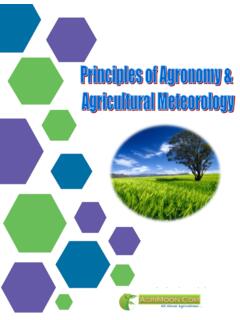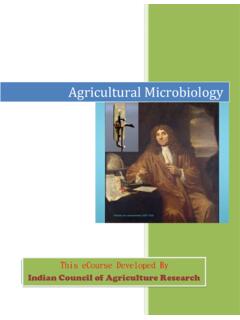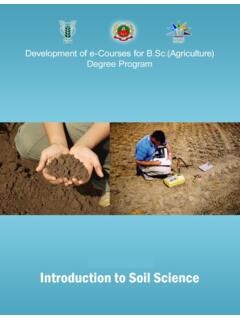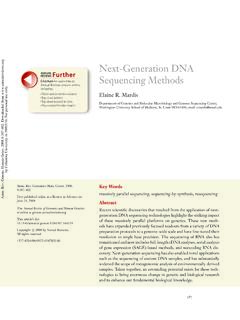Transcription of Apiculture - AgriMoon
1 Apiculture Page 1 Dr. J. K. Gupta Dr. V. V. Belavadi Sh. Mohinder Singh Apiculture Apiculture Page 2 Apiculture Course creator Dr. J. K. Gupta Sr. Scientist, Dept. of Entomology & Apiculture , College of Horticulture, YSPUH&F Nauni, Solan (HP) Course moderator Dr. V. V. Belavadi Professor (Entomology), College of Agriculture, GKVK, UAS Bangalore Research Associate Sh. Mohinder Singh College of Horticulture, YSPUH&F Nauni, Solan (HP) Index SN Chapter Page No 1. Introduction to Apiculture : Importance and history 4-5 2. Different species of honey bees 6-9 3. Morphology and anatomy of honey bee 10-13 4. Colony organization and life cycle 14-18 5. Social behaviour of honey bees 19-22 6. Beekeeping equipment 23-27 7. Handling of bee colony and maintenance of apiary Record 28-31 8. Collection and preservation of bee pasture 32-34 9. Seasonal management of honey bee colonies: Spring management 35-38 10.
2 Seasonal management of honey bee colonies: Summer, monsoon and autumn season management 39-43 11. Seasonal management of honey bee colonies: Winter management and migratory beekeeping 44-46 12. Miscellaneous management (uniting, dividing, queen management, supplementary feeding, shifting bee colonies, robbing and absconding) 47-53 13. Manipulation for honey production 54-57 14. Economics of beekeeping 58-59 15. Queen rearing 60-63 16. Familiarization with enemies of honey bees and their control 64-68 17. Familiarization with diseases of honey bees and their control 69-71 Apiculture Page 4 Lecture 1 INTRODUCTION TO Apiculture : IMPORTANCE AND HISTORY Insects are dominant animals on this earth. Usually insects are considered harmful to man but hardly 1 per cent of insect species fall in the pest category. Benefits of insects in maintaining economy outweigh the injury inflicted. Honey bees are one of the few insects directly beneficial to man.
3 In the animal kingdom honey bees belong to: Phylum-Arthropoda, Class- Insecta, Order-Hymenoptera, Superfamily-Apoidea and Family-Apidae. Honey is highly valued food produced by honey bees and it is also used as medicine. In addition to honey, other products like bees wax, pollen, royal jelly and bee venom are also produced by honey bees. More than the producers of these hive products; bees play an important role in pollination of plants while collecting their food from flowers in the form of nectar and pollen. Pollination is involved in a chain of complex events significant to our economy. Pollination by insects including honey bees is important for ecological balance. Visitation by honey bees between distant varieties or cultivars promotes hybridization and help sparse populations to survive. Their mutual dependency has resulted into great degree of co-evolution. The science of rearing honey bees or beekeeping is known as Apiculture .
4 We can learn a lot from these little wonderful creatures. Honey bees are admired for Their industriousness Unity Self sacrifice Tolerance Division of labour Even the most feared bee stings help in healing muscular pains, rheumatism, arthritis and reduction in cholesterol level. Beekeeping can be practiced as An ideal hobby Part-time business. Full-time business. History of beekeeping Primitive man used to rob bee colonies found in the cavities of hollow trees or on rocks and in traditional mud houses (Fig. ) and this is still being followed by some tribes There was no development in beekeeping until 16th century. Proper beekeeping started only when man started giving protection to colonies found in the nature Apiculture Page 5 Idea to keep bees in log hives has been reported to come from the fallen trees which were nested by the cavity nesting bees. Development of modern beekeeping has its origin between 1500 and 1851 when many attempts were made to domesticate bees in different types of hives but were not successful because bees attached their combs together as well as to the walls of hive and combs required had to be cut for honey.
5 The discovery of the principle of bee space in 1851 by L. L. Langstroth in USA resulted in first truly movable frame hive. This bee space was mm for Apismellifera. This discovery was followed by subsequent innovations like comb foundation mill, honey extractor, smoker, etc., which helped in the development of modern beekeeping we see today. Beekeeping in India In India first attempt to keep bees in movable frame hives was made in 1882 in Bengal and then in 1883-84 in Punjab. In south India, Rev. Newton during 1911-1917 trained several beekeepers and devised a hive for indigenous bee Apiscerana based on principle of bee space (which was named after his name as Newton hive ). Beekeeping was also started in the Travancore state (now Cochin) in 1917 and in Mysore in 1925. In Himachal Pradesh modern beekeeping with indigenous honey bee A.
6 Cerana started in 1934 at Kullu and in 1936 at Kangra. The exotic bee A. mellifera was successfully introduced for the first time in India in 1962 at NagrotaBagwan (then in Punjab state and now in Himachal Pradesh), because this bee has potentials to produce more honey. At present both the hive bee species are being used in modern beekeeping and lot of honey is also being collected from the wild bees viz. A. dorsata and A. florea. India is producing approximately 70000 metric tons of honey annually from all the four species of honey bees. ** ** Apiculture Page 6 Lecture 2 DIFFERENT SPECIES OF HONEY BEES There are four well known species of true honey bees (belonging to genus Apis) in the world: i. Rock bee, Apisdorsata F. (Fig. ) ii. Little bee, A. florea F. (Fig. ) iii. Asian bee, A. cerana F. (Fig. ) iv. European bee, A. mellifera L. (Fig. ) Characteristics of four well known species of honey bees: Apiculture Page 7 Apisdorsata Apisflorea Apiscerana Apismellifera Nesting Open nesting.
7 Builds single large comb (ca 1m2) attached to branches of trees or rocks etc. Open nesting. Builds single small comb (ca size of palm of hand) fixed to branches of bushes. Cavity nesting. Builds many parallel combs in cavities of tree trunks, hollows of rocks, poles and other covered places Cavity nesting and similar in habits to Apiscerana and builds parallel combs. Distribution in India Found in plains as well as hills up to 1600 metres above sea level. Highly migratory. Found in plains up to 300 metres above sea level. Highly migratory. Found throughout India having 3 subspecies Exotic bee to India. Introduced successfully in 1962. It has many subspecies (more than 23)throughout world Size Biggest honey bee (16-18mm) Smallest Apis bee (9-10mm) Medium size (14-15mm) Medium size (14-16mm) Swarming/ Absconding Strong tendency Strong tendency Strong tendency Only in African sub species Temperament Furious Mild Furious Gentle except African sub species Average honey yield per colony/year 40 kg (wild bees; cannot be domesticated) 500 g (wild bees; cannot be domesticated) 5 kg (Hive bees; can be domesticated) 15 kg Hive bees; can be domesticated) Method of honey extraction By squeezing (unhygienic) By squeezing (unhygienic) By centrifugal honey extractor from the hived bees (hygienic).
8 By centrifugal honey extractor from the hived bees (hygienic). Number of cells/10cm comb (worker cells) 18-19 32-36 21-25 17-19 SPECIES AND SUBSPECIES OF HIVE BEES Apiculture Page 8 It is important to know difference between a species and subspecies. Species are reproductively isolated from each other and these cannot interbreed where as subspecies are geographically isolated and can interbreed Among the two domestic bee species, each has many subspecies in different parts of the world Apiscerana has three subspecies in India: A. ceranacerana in Himachal Pradesh and Jammu and Kashmir (North India) A. ceranaindica in Kerala, Tamilnadu and Karnataka. (South India) A. ceranahimalaya in Nagaland, Manipur, Mizoram, Assam and Meghalaya. (Eastern parts of India) In addition to above three subspecies, A. cerana japonica has been identified from Japan. A. mellifera has many subspecies which can be placed under three groups: 1. Eastern subspecies 2.
9 European subspecies 3. African subspecies Eastern subspecies: i. Apismelliferaremipes (in Iran) ii. A. melliferasyriaca (in Syria, Israel and Lebanon) These subspecies are not suitable for modern beekeeping European subspecies: i. A. melliferamellifera (Dark Dutch or German bee) ii. A. melliferacarnica (Carniolan bee; in Southern Austria) iii. A. melliferaligustica (Italian bee; Italy) iv. A. melliferacaucasica (Caucasican bee; USSR) African subspecies: Some of the important subspecies are: i. A. melliferaintermissa (Tellian bee; Morocco and Lybia) ii. A. melliferalamarckii (Egyptian bee; restricted to the Nile Valley) iii. A. melliferacapensis (Cape bee; the only bee which can rear queen from eggs laid by workers) iv. A. melliferaadansonii (African bee; also known as killer bee) In India, all the four bee species are found. A. mellifera is an exotic bee which was introduced in India for the first time successfully in 1962 at NagrotaBagwan, Himachal Pradesh.
10 Honey yield from this species from stationary beekeeping varies from 10-15 kg/colony but through migration yield increases to 45-60 kg/colony. One beekeeper in Himachal has extracted as much as 110kg honey from a single colony of A. mellifera which is indicative of its potentials. Other species found in different parts of the world: In addition to the four Apis honey bee species, more species have been reported from some parts of the world. i. Apislaboriosa (from Bhutan, Yunnan and Nepal) ii. A. breviligula (from Philippines) binghami (from Sulawesi) Above three species resemble A. dorsata and are wild iv. A. andreniformis (from China) It resembles A. florea. v. A. koschevnikovi (from Malaysia) Apiculture Page 9 vi. A. nuluensis (from Malaysia, Indonesia) vii. A. nigrocincta (from Indonesia). These three species (v - vii) resemble A. cerana. Stingless honey bees: In addition to honey bees of genus Apis, stingless honey bees also provide honey which are: i) Melipona sp.
















